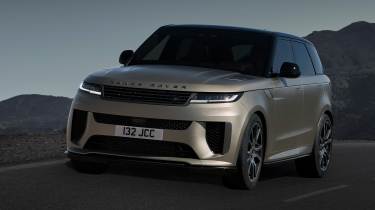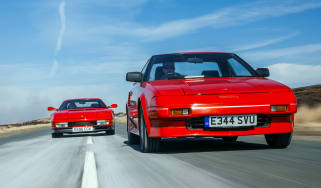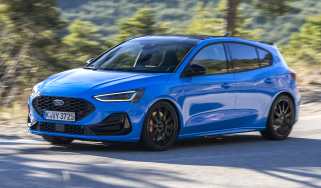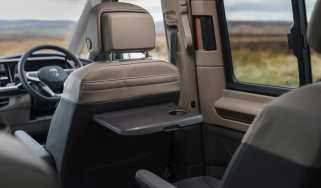New 2024 Range Rover Sport SV: 626bhp twin-turbo V8 for SVR successor
JLR’s Special Vehicles division has created a faster, leaner Range Rover Sport with a mild-hybrid V8 and a chassis fit for a supercar
The brash, bold and indecently fast Range Rover Sport SVR carved its own niche among performance SUVs when it launched in 2015, and now its replacement has arrived to carry the torch: the Range Rover Sport SV. Swapping the old car’s 5.0-litre supercharged V8 for the smaller BMW 4.4-litre turbocharged V8 unit that’s fitted to the regular Sport, the SV is the most powerful Range Rover to date, and by far the most advanced in terms of its chassis. At £171,460 in sold-out Edition One launch spec, it’s also eye-wateringly expensive.
The new flagship uses a 4.4-litre V8 that generates 626hp and 553lb ft of torque, thanks in part to a 48V mild-hybrid system that employs a starter-generator unit to recoup energy and deploy extra power. With wider 305-section tyres at the rear, the SV digs in to launch from 0-62mph in 3.8 seconds, and on to 180mph flat out. That puts the Range Rover in a similar ballpark to the RS Q8, but the SV treatment goes beyond raw firepower.
Land Rover has developed what it calls a ‘6D’ suspension system for the Sport SV, and it includes an advanced suite of hard and software to sharpen its responses, control the car’s bulk and build on the standard car’s impressive levels of ride comfort. Height adjustable air suspension is familiar to other Range Rovers, but the SV adopts a new rear subframe, bespoke geometry and a set of hydraulically interlinked dampers which negate the need for anti-roll bars at both axles. A similar solution to the one used by McLaren, by using the interlinked dampers for roll support rather than anti-roll bars, the wheels at each axle are effectively decoupled and better able to isolate bumps from the rest of the car.
It’s an incredibly complex and advanced system for such a car, one that is claimed to enhance the car’s on road behaviour to a level higher than its competitor set, without compromising the off-road credentials expected of a Range Rover.
Depending on the chosen drive mode, the SV rides between 10mm and 25mm lower than a standard V8 engined Range Rover Sport, with specific tuning for its four-wheel drive and rear-wheel steering systems. The SV also features a quicker steering rack and torque vectoring by braking to tuck into corners more keenly, with a locking rear differential for better drive on the way out. As ever, drivers can choose from a plethora of modes to alter the SV’s dynamic behaviour, from its exhaust note to damper stiffness, with a lenient TracDSC stability control program available to explore the car’s outer limits.
Weight saving might seem incongruous in the context of a 2560kg SUV, but Land Rover offers optional Brembo carbon ceramic brakes to reduce unsprung mass by a significant 34kg, with optional 23-inch carbonfibre wheels – the largest of their kind and a world first according to Land Rover – trimming a further 35.6kg. Regardless of the wheel size and finish the SV is equipped as standard with a set of Michelin all-season tyres.
Carbon is also used for the bonnet, quad exhaust tips and various exterior trims, combining with the SV’s sculpted front bumper, sills and rear valance. The design is arguably less assertive than later editions of the SVR, but some of that aggression is restored by optional exposed carbon finishes or with the sold-out Edition One model, which features additional badging and graphics and is only available in three exterior and interior colour combinations.
The SV modifications continue inside, with carbon-backed ‘Body and Soul’ seats that incorporate sensory technology to enhance the listening experience through the 1430W Meridian sound system. The Range Rover’s familiar 13.1-inch Pivi Pro infotainment system is mounted to the dash, offering Apple CarPlay, 4G connectivity and an Amazon Alexa voice assistant. For the first year of production, the new Sport SV is available to order by invitation-only in Edition One spec, all of which have been spoken for – the standard SV will go on sale later.
Price and rivals
Super-SUVs were still somewhat of a novelty when the original SVR launched, and the new SV faces a much sterner test against diverse competition. Costing from £171,460 in Edition One guise (expect the price to come down for the standard model), the SV has effectively moved up a category to challenge the most talented, luxurious SUVs on sale, as well as more mainstream rivals. The recently facelifted BMW X5 M and X6 M use the same twin-turbo V8 as the Range Rover, but given that the previous models left us cold with jarring ride quality and lifeless steering, the updates will need to be comprehensive to reach the top of the class.
Speaking of which, the Aston Martin DBX is one of our favourite SUVs of the moment, with the deftness and precision you’d expect from a super saloon. The DBX707 ups the intensity further, as does the 657bhp Lamborghini Urus S with its sledgehammer powertrain and revised chassis. The overhauled Porsche Cayenne Turbo GT would also be a worthy contender, if it was available to buy in Europe.
With 542bhp, Bentley’s Bentayga V8 S offers significantly less power than the Range Rover but counters with supreme build quality and opulence inside, while sharing its engine and architecture with the more driver focused RS Q8. None of the aforementioned rivals offer the same level of chassis sophistication as the Range Rover – in fact, it’s only bettered in this regard by the Ferrari Purosangue, which uses fully active Multimatic TrueActive dampers at each corner. At £313,120 before options, the Ferrari sits in a different stratosphere in terms of price.






